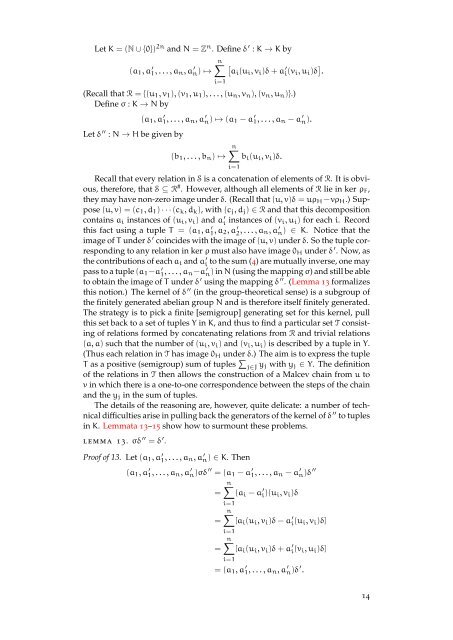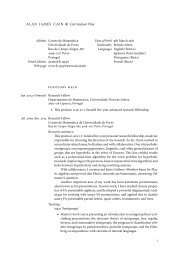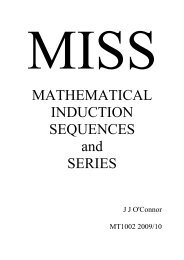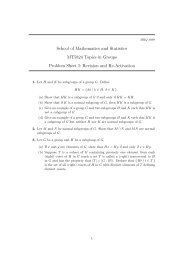Malcev presentations for subsemigroups of direct products of ...
Malcev presentations for subsemigroups of direct products of ...
Malcev presentations for subsemigroups of direct products of ...
Create successful ePaper yourself
Turn your PDF publications into a flip-book with our unique Google optimized e-Paper software.
Let K = (N ∪ {0}) 2n and N = Z n . Define δ ′ : K → K byn∑(a 1 , a 1 ′ , . . . , a n, a n) ′ [↦→ ai (u i , v i )δ + a i ′ (v i, u i )δ ] .i=1(Recall that R = {(u 1 , v 1 ), (v 1 , u 1 ), . . . , (u n , v n ), (v n , u n )}.)Define σ : K → N byLet δ ′′ : N → H be given by(a 1 , a ′ 1 , . . . , a n, a ′ n) ↦→ (a 1 − a ′ 1 , . . . , a n − a ′ n).(b 1 , . . . , b n ) ↦→n∑b i (u i , v i )δ.Recall that every relation in S is a concatenation <strong>of</strong> elements <strong>of</strong> R. It is obvious,there<strong>for</strong>e, that S ⊆ R # . However, although all elements <strong>of</strong> R lie in ker ρ F ,they may have non-zero image under δ. (Recall that (u, v)δ = uρ H −vρ H .) Suppose(u, v) = (c 1 , d 1 ) · · · (c k , d k ), with (c j , d j ) ∈ R and that this decompositioncontains a i instances <strong>of</strong> (u i , v i ) and ai ′ instances <strong>of</strong> (v i, u i ) <strong>for</strong> each i. Recordthis fact using a tuple T = (a 1 , a1 ′ , a 2, a2 ′ , . . . , a n, a n) ′ ∈ K. Notice that theimage <strong>of</strong> T under δ ′ coincides with the image <strong>of</strong> (u, v) under δ. So the tuple correspondingto any relation in ker ρ must also have image 0 H under δ ′ . Now, asthe contributions <strong>of</strong> each a i and ai ′ to the sum () are mutually inverse, one maypass to a tuple (a 1 −a1 ′ , . . . , a n−a n) ′ in N (using the mapping σ) and still be ableto obtain the image <strong>of</strong> T under δ ′ using the mapping δ ′′ . (Lemma <strong>for</strong>malizesthis notion.) The kernel <strong>of</strong> δ ′′ (in the group-theoretical sense) is a subgroup <strong>of</strong>the finitely generated abelian group N and is there<strong>for</strong>e itself finitely generated.The strategy is to pick a finite [semigroup] generating set <strong>for</strong> this kernel, pullthis set back to a set <strong>of</strong> tuples Y in K, and thus to find a particular set T consisting<strong>of</strong> relations <strong>for</strong>med by concatenating relations from R and trivial relations(a, a) such that the number <strong>of</strong> (u i , v i ) and (v i , u i ) is described by a tuple in Y.(Thus each relation in T has image 0 H under δ.) The aim is to express the tupleT as a positive (semigroup) sum <strong>of</strong> tuples ∑ j∈J y j with y j ∈ Y. The definition<strong>of</strong> the relations in T then allows the construction <strong>of</strong> a <strong>Malcev</strong> chain from u tov in which there is a one-to-one correspondence between the steps <strong>of</strong> the chainand the y j in the sum <strong>of</strong> tuples.The details <strong>of</strong> the reasoning are, however, quite delicate: a number <strong>of</strong> technicaldifficulties arise in pulling back the generators <strong>of</strong> the kernel <strong>of</strong> δ ′′ to tuplesin K. Lemmata – show how to surmount these problems. . σδ ′′ = δ ′ .i=1Pro<strong>of</strong> <strong>of</strong> 13. Let (a 1 , a ′ 1 , . . . , a n, a ′ n) ∈ K. Then(a 1 , a 1 ′ , . . . , a n, a n)σδ ′ ′′ = (a 1 − a 1 ′ , . . . , a n − a n)δ ′ ′′n∑= (a i − a i ′ )(u i, v i )δ==i=1n∑[a i (u i , v i )δ − a i ′ (u i, v i )δ]i=1n∑[a i (u i , v i )δ + a i ′ (v i, u i )δ]i=1= (a 1 , a ′ 1 , . . . , a n, a ′ n)δ ′ .














